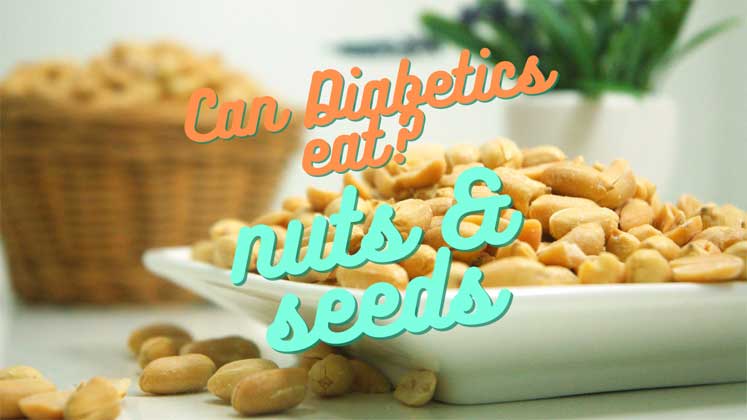
Can Diabetics eat nuts & Seeds? Why not! However, the intake should not be too high. Nuts and Seeds, can be consumed, to obtain nutrients like fibre, minerals, vitamins, and oxidants. Consequently, they also help in the regulation, lowering of blood sugar as well as supporting blood sugar levels.
Fruits and Nuts Diabetics can eat.
Nuts and seeds are not only generally considered to be good for health due to low glycemic index, but also, these are very beneficial in diabetes. Let us find the safest nuts and seeds for diabetes.
#1 Almond: [Glycemic index : 0]
Eat nuts if you have too much sugar? Why not! Almond is 0 on the glycemic index, which means, it can not make your blood sugar (glucose) rise. The amount of carbohydrates found in almonds is negligible and, mainly fibres.
Almond can control insulin levels. It lowers your sugar level, whether taken, before a meal or after a meal. You can also consume almonds as a preventive measure against diabetes or heart problems as it reduces the oxidative stress of the body.
How many almonds should you eat a day?
The safe limit is 6-8 almonds! Almonds are, however, only good as long as you consume them within an appropriate quantity. That is because its over-consumption can increase hydrocyanic acid leading to breathing problems or more serious medical conditions.
It is best to eat almonds raw and without salt. You can roast them a little, but avoid roasting in oil. You can eat finely chopped almonds, with breakfast, salad or yoghurt.
#2 Walnut: [Glycemic index : 15]
Walnuts are good for diabetics. The Glycemic index of walnut is 15, a reason why high sugar patients, can safely eat walnuts.
The oil present in walnuts can increase antioxidant activity in cells with high blood glucose levels. These low cab and fiber rich item perfectly fits into the nutrition plan for diabetic seniors especially.
Taking walnuts helps to develops power against resistance to insulin as well as cuts the risk of type-2 diabetes.
Again, eating walnuts every day relieves oxidative stress, a cause to many other problems related to diabetes.
How many walnuts in a day?
Consuming 7-8 walnuts every day has a positive effect on the weight and insulin levels in Diabetics.
It is better to eat a walnut raw with peels, although its peel is slightly bitter. Before buying the walnut, sniff it and see if it has become stale. Before purchasing the walnut, always smell to check to find, whether it is fresh or not. In typical scenarios, you can crush and pour walnuts on the salad, gently roasted vegetables or yoghurt.
#3 Pistachio: [Glycemic index : 18]
Pistachios and Gestational Diabetes: A low glycemic index food is beneficial for patients of diabetes. Pistachios, in this regard, have a low-glycemic index of 18, making it safe for people with high sugar level. In gestational diabetes and type-2 diabetes, pistachio nuts are very beneficial.
Moreover, administering pistachios to a person with diabetes reduces their blood glucose levels. Again, pistachio decreases the HbA1c, the average level of blood sugar over the past 2 to 3 months. The nuts also lower a spike in sugar level after the meal.
How many pistachios in a day?
At most, 30 pistachio nuts can be taken daily by diabetic patients.
Prefer to buy pistachios with peel and, remove the skin just before eating. Salted pistachios, on the contrary, do not help diabetes patients to a great extent. You can add crushed pistachios to fruits or salads to add some variety.
#4 Pumpkin Seeds: [GI:75, Glycemic Load 3]
A high Glycemic Index of Pumpkin seeds can make some people think, pumpkin not suitable for diabetic people. However, the other half of the story is its low glycemic load! Which means,
you can still obtain the benefits by eating it in small quantities. For example, some ingredients like high magnesium in pumpkin seeds reduce blood glucose levels. Due to the presence of dietary fibres, the consumption of pumpkin seeds also not only helps to maintain blood sugar level in patients with type-2 diabetes but also cuts the risks.
How many pumpkin seeds in a day?
In a safe scenario, a diabetic person can eat 1/2 cup of pumpkin seeds in the daily routine. You can take the pumpkin seeds raw or lightly roasted. Or else, you can mix it in soup, cereal, salad, smoothie or yoghurt.
#5 Flax seeds [Glycemic Index: 32]
Are flaxseeds high in sugar? No! With a low GI, Flax seeds are among the list of foods that don’t turn into sugar due to its richness in rich in roughage, omega-3 fatty acids, and useful plant composites. Experts also establish the effects of flaxseed oil on anxiety and stress level.
Together with its multiple health benefits, having flaxseed powder also helps reduce the level of fasting blood glucose and HbA1c. A study on flaxseed and insulin sensitivity says flaxseed as diet supplement decreases insulin resistance[1].
How much flax seeds in a day?
Ten grams or one tablespoon of flax seeds powder per day, is enough, to safely deliver the health benefits for diabetes patients.
Flaxseed seeds should bet chewed appropriately, else, it does not benefit to the full. You can consume flax seeds powder mixed with cooked food, oatmeal, cereal, smoothie and curd. You can also sprinkle a small number of its flax seeds powder in the flour or pre-made plain sliced bread loaves.
#6 Chia seeds: [Glycemic Index: 1]
Chia seeds and diabetes: The gi of chia seeds is one and, many studies have shown that it significantly reduces blood sugar levels. A 2017 finding observed that people with diabetes were less likely to have heart-related illnesses by eating chia seeds. If people with diabetes take it as a supplement with their food, it can help avert cardiovascular complications.
How much Chia seeds in a day?
You can safely consume twenty grams (1 tablespoon) of chia seeds, twice per day. Chia seeds are quite soft and do not need to grind like flax seeds. You can add them in cereals of breakfast apart from pudding, oatmeal, vegetables or rice.
Conclusion:
Finally, we have analysed our basic question, Can diabetics eat nuts & seeds? If you are excited to include the nuts and seeds to control your diabetes, it is useful to know the quantity in general.
The AHA suggests having a handful of nuts and seeds four times a week. These nuts and seeds are, no doubt, healthy but also contain calories. Hence, always consume them in a regulated amount.

Lifebing is driven by an unrelenting passion for promoting health and well-being, our team is wholly committed to curating exceptional content and immersive experiences.
